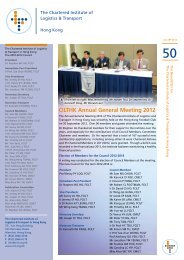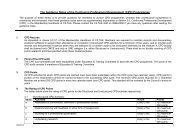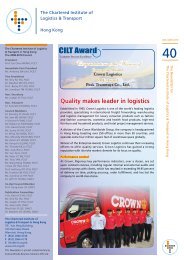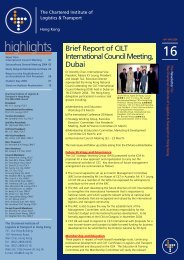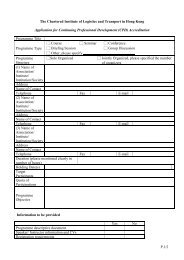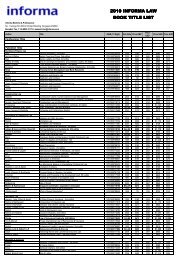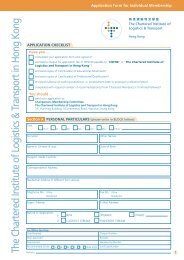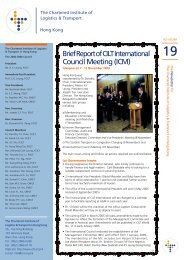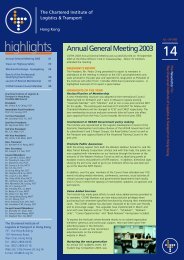to view file - The Chartered Institute of Logistics and Transport in ...
to view file - The Chartered Institute of Logistics and Transport in ...
to view file - The Chartered Institute of Logistics and Transport in ...
Create successful ePaper yourself
Turn your PDF publications into a flip-book with our unique Google optimized e-Paper software.
10<br />
CILTHK Newsletter issue 8<br />
a study <strong>of</strong> ...<br />
Attitudes <strong>of</strong> Young People<br />
<strong>in</strong> Hong Kong <strong>to</strong> Cars <strong>and</strong><br />
Public <strong>Transport</strong><br />
Dr Sharon Cull<strong>in</strong>ane, Associate Pr<strong>of</strong>essor,<br />
<strong>The</strong> University <strong>of</strong> Hong Kong<br />
1. Introduction.<br />
Reduc<strong>in</strong>g car dependence has<br />
become one <strong>of</strong> the key transport<br />
objective <strong>of</strong> many developed<br />
countries. Hong Kong is <strong>in</strong> the<br />
envious position <strong>of</strong> never hav<strong>in</strong>g<br />
become one <strong>of</strong> these many cardependent<br />
locations, despite<br />
relatively high levels <strong>of</strong> wealth. Car<br />
ownership <strong>in</strong> Hong Kong is very low<br />
at only 48 cars/1000 population<br />
compared <strong>to</strong>, for <strong>in</strong>stance, 377 <strong>in</strong><br />
the UK, 325 <strong>in</strong> Japan <strong>and</strong> 485 <strong>in</strong> the<br />
US (HK <strong>Transport</strong> Bureau 2001). GDP<br />
per person, however, at HKD179,<br />
803 ($US 23,000) <strong>in</strong> 2000 is very<br />
similar <strong>to</strong> those <strong>of</strong> the UK <strong>and</strong><br />
France. <strong>The</strong> question is whether<br />
Hong Kong can ma<strong>in</strong>ta<strong>in</strong> this<br />
position or whether car ownership<br />
<strong>and</strong> use will <strong>in</strong>crease <strong>in</strong> the future.<br />
This will depend <strong>to</strong> a great extent on<br />
the attitudes <strong>and</strong> <strong>in</strong>tentions <strong>of</strong><br />
young people <strong>to</strong>wards car<br />
ownership. Young people are the<br />
potential car owners <strong>and</strong> users <strong>of</strong><br />
the future. By determ<strong>in</strong><strong>in</strong>g their<br />
<strong>view</strong>s on car ownership <strong>and</strong> public<br />
transport, we should learn a great<br />
deal about future trends.<br />
In order <strong>to</strong> ascerta<strong>in</strong> the <strong>view</strong>s <strong>of</strong><br />
young people <strong>to</strong>wards car<br />
ownership <strong>and</strong> public transport<br />
use, a self-completion<br />
questionnaire survey was<br />
undertaken <strong>of</strong> 340 young (between<br />
the ages <strong>of</strong> 18 <strong>and</strong> 24 <strong>in</strong>clusive),<br />
local Hong Kong people, r<strong>and</strong>omly<br />
chosen at locations throughout<br />
Hong Kong (<strong>in</strong>clud<strong>in</strong>g the New<br />
Terri<strong>to</strong>ries). <strong>The</strong> survey was carried<br />
out <strong>in</strong> May 2001 <strong>and</strong> was<br />
conducted <strong>in</strong> Can<strong>to</strong>nese <strong>and</strong><br />
subsequently translated <strong>in</strong><strong>to</strong><br />
English.<br />
2. Car Ownership <strong>and</strong><br />
Licence hold<strong>in</strong>g.<br />
Amaz<strong>in</strong>gly, less than 4% <strong>of</strong><br />
respondents owned a car<br />
themselves. This is much lower<br />
than other developed countries <strong>and</strong><br />
illustrates the potential for HK <strong>to</strong><br />
rema<strong>in</strong> relatively traffic free. Only<br />
25% <strong>of</strong> respondent’s families had a<br />
car. However, 15% <strong>of</strong> respondents<br />
had a driv<strong>in</strong>g licence themselves<br />
<strong>and</strong> a further 3% were learn<strong>in</strong>g <strong>to</strong><br />
drive. Although the majority <strong>of</strong><br />
respondent’s families do not have a<br />
car, around 70% have at least one<br />
member with a full driv<strong>in</strong>g licence,<br />
with 37% hav<strong>in</strong>g more than one.<br />
This may be an illustration <strong>of</strong> the<br />
latent dem<strong>and</strong> for cars. Other<br />
possible explanations for the<br />
considerably higher number <strong>of</strong><br />
licences than cars <strong>in</strong> respondent’s<br />
families are:<br />
1. some people may have obta<strong>in</strong>ed<br />
a licence <strong>and</strong> driven a car<br />
overseas.<br />
2. some families may have had a<br />
car <strong>in</strong> the past <strong>and</strong> have<br />
subsequently sold or scrapped it<br />
3. some people may have a driv<strong>in</strong>g<br />
licence for work purposes (e.g.<br />
bus or truck drivers) but do not<br />
own a car personally.<br />
Family car ownership was<br />
significantly related <strong>to</strong> area <strong>of</strong><br />
residence with more respondents<br />
from the NT hav<strong>in</strong>g cars <strong>in</strong> the<br />
family than from the isl<strong>and</strong>. <strong>The</strong><br />
higher car ownership <strong>in</strong> the New<br />
Terri<strong>to</strong>ries might be related <strong>to</strong><br />
greater need (because travel<br />
distances are longer <strong>and</strong> public<br />
transport is less good) or the<br />
greater availability <strong>and</strong> cheaper cost<br />
<strong>of</strong> car park<strong>in</strong>g.



